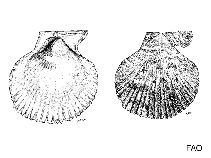Pecten sinensis Sowerby, 1842
| Native range | All suitable habitat | Point map | Year 2050 |

|
| This map was computer-generated and has not yet been reviewed. |
| Pecten sinensis AquaMaps Data sources: GBIF OBIS |
Google image | No image available for this species;
drawing shows typical species in Pectinidae.
Classification / Names Κοινά ονόματα | Συνώνυμα | CoL | ITIS | WoRMS
Bivalvia | Pectinida | Pectinidae
Environment: milieu / climate zone / εύρος βάθους / distribution range Οικολογία
, usually 10 - 50 m (Αναφ. 75831). Subtropical
Distribution Χώρες | Περιοχές FAO | Οικοσυστήματα | Παρουσίες | Εισαγωγές
Northwest Pacific: China, Taiwan and Japan.
Length at first maturity / Μέγεθος / Weight / Age
Γεννητική Ωρίμανση: Lm ? range ? - ? cm
Life cycle and mating behavior Γεννητική Ωρίμανση | Αναπαραγωγή | Γεννοβολία | Eggs | Γονιμότητα | Larvae
Main reference
Αναφορές | Συντονιστής | Συνεργάτες
Scott, P.H. 1994 Bivalve molluscs from the southeastern waters of Hong Kong. pp. 55-100 In B. Morton (ed.) The Malacofauna of Hong Kong and Southern China III, Proceedings of the Third International Workshop on the Malacofauna of Hong Kong and Southern China, Hong Kong, 13 April - 1 May 1992. Hong Kong University Press. (Αναφ. 77650)
IUCN Red List Status
(Αναφ. 130435: Version 2025-1)
CITES status (Αναφ. 108899)
CMS (Αναφ. 116361)
Threat to humans
Human uses
| FishSource |
Εργαλεία
Περισσότερες πληροφορίες
Σύσταση δίαιτας
Κατανάλωση τροφής
Θηρευτές
Max. ages / sizes
Length-weight rel.
Length-length rel.
Length-frequencies
Mass conversion
Αφθονία
Διαδικτυακές πηγές
BHL | BOLD Systems | CISTI | DiscoverLife | FAO(Publication : search) | Fishipedia | GenBank (genome, nucleotide) | GloBI | Gomexsi | Google Books | Google Scholar | Google | PubMed | Δέντρο Ζωής | Wikipedia (Go, αναζήτηση) | Zoological Record



